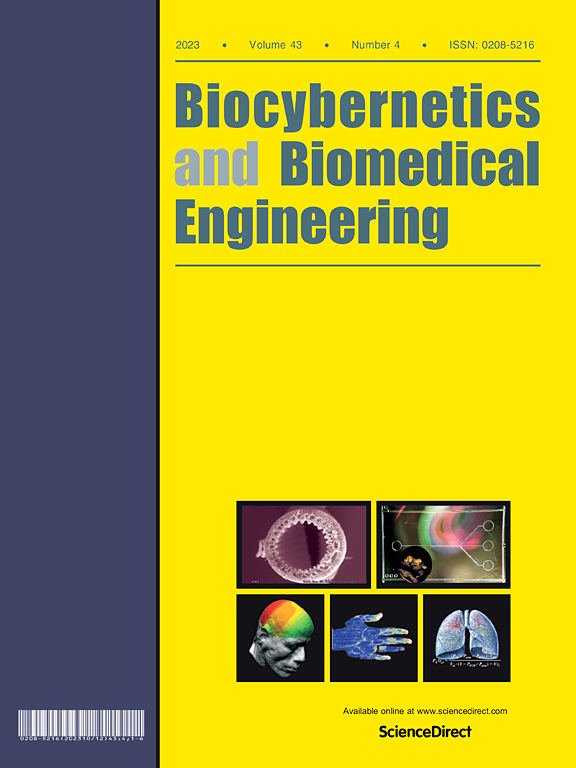A multidomain 0D model for continuous positive airway pressure ventilation circuit design: Validation and applications
IF 6.6
2区 医学
Q1 ENGINEERING, BIOMEDICAL
引用次数: 0
Abstract
This study focuses on optimizing a non-invasive ventilation (NIV) circuit for the treatment of hypoxemic respiratory failure using continuous positive airway pressure (CPAP). A multidomain 0D in silico approach was employed, creating a lumped circuit model of an innovative NIV-CPAP system in Mathworks® Simulink. The model relies on in vitro tests on commercial components characterizing pneumatic resistive behavior, and it exploits an extended resistance-inductance-capacitance model for the patient’s respiratory system, recurring to sigmoidal pressure–volume behavior characteristic of pathological conditions. The NIV-CPAP system was assembled in vitro and connected to a lung simulator to validate the model under healthy and pathological conditions (acute respiratory distress syndrome and chronic obstructive pulmonary disease). The study explored the impact of key features on the ventilation circuit, such as interface leakage, air volume within the circuit, and resistance induced by circuit components.
Validation of the 0D model through in vitro tests showed correlation coefficients between 0.9 and 1. Interface leakage caused reductions of up to 6% in delivered static pressure. Changes in air volume (mask or helmet interface, reservoirs adding) resulted in a maximum 8% decrease in pressure oscillations. Increased resistances from the starting ventilation circuit produced a tidal volume reduction of less than 1%. An optimized configuration that balanced resistances between limbs improved intrinsic positive end-expiratory pressure generation.
The proposed 0D model proved to be effective in guiding the design of the innovative device, providing computational efficiency and flexibility; it demonstrated its reliability as a tool to support the optimization of non-invasive ventilation circuits.
持续气道正压通气回路设计的多域0D模型:验证与应用
本研究的重点是优化使用持续气道正压通气(CPAP)治疗低氧性呼吸衰竭的无创通气(NIV)回路。采用多域0 - d芯片方法,在Mathworks®Simulink中创建了创新NIV-CPAP系统的集总电路模型。该模型依赖于表征气动电阻行为的商业组件的体外测试,并利用患者呼吸系统的扩展电阻-电感-电容模型,重现病理条件下的s型压力-体积行为特征。体外组装NIV-CPAP系统并连接到肺模拟器,在健康和病理条件下(急性呼吸窘迫综合征和慢性阻塞性肺疾病)验证模型。该研究探讨了关键特征对通风回路的影响,如界面泄漏、回路内的风量以及回路元件引起的阻力。通过体外实验验证0D模型,相关系数在0.9 ~ 1之间。界面泄漏导致输送静压降低高达6%。空气量的变化(面罩或头盔界面,增加储层)导致压力振荡最大减少8%。启动通风回路的阻力增加导致潮气量减少不到1%。平衡四肢阻力的优化配置改善了固有的呼气末正压产生。所提出的0D模型能够有效地指导创新器件的设计,具有较高的计算效率和灵活性;它证明了其作为支持无创通气回路优化的工具的可靠性。
本文章由计算机程序翻译,如有差异,请以英文原文为准。
求助全文
约1分钟内获得全文
求助全文
来源期刊

Biocybernetics and Biomedical Engineering
ENGINEERING, BIOMEDICAL-
CiteScore
16.50
自引率
6.20%
发文量
77
审稿时长
38 days
期刊介绍:
Biocybernetics and Biomedical Engineering is a quarterly journal, founded in 1981, devoted to publishing the results of original, innovative and creative research investigations in the field of Biocybernetics and biomedical engineering, which bridges mathematical, physical, chemical and engineering methods and technology to analyse physiological processes in living organisms as well as to develop methods, devices and systems used in biology and medicine, mainly in medical diagnosis, monitoring systems and therapy. The Journal''s mission is to advance scientific discovery into new or improved standards of care, and promotion a wide-ranging exchange between science and its application to humans.
 求助内容:
求助内容: 应助结果提醒方式:
应助结果提醒方式:


